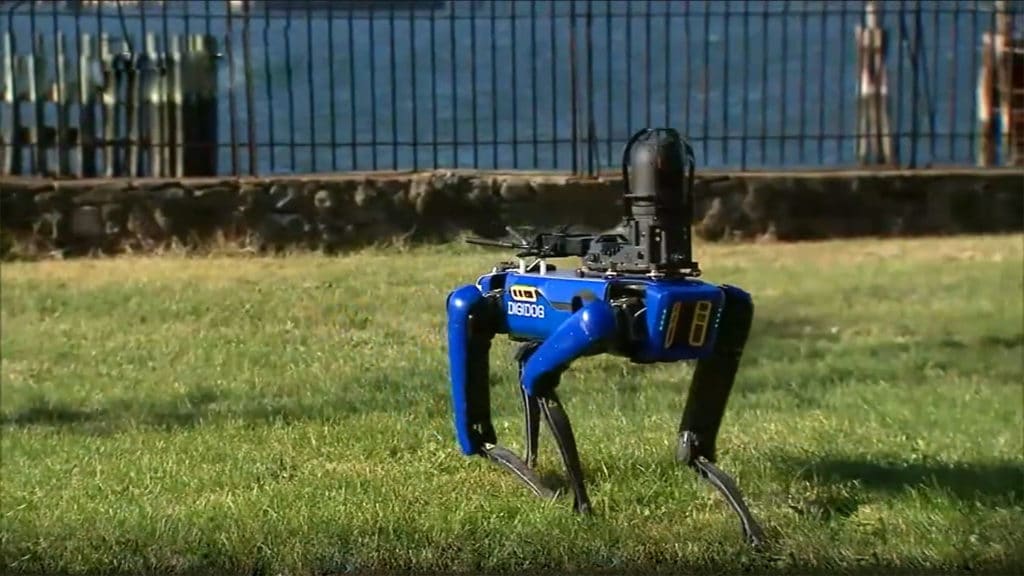
Robodogs in the police service
The New York City Police Department is using Digidog - robotic dogs from Boston Dynamics, although it is still in test mode. It is planned that they will be used in dangerous situations when there is a risk to the lives of police officers. Among the stated advantages of Digidog is the ability to see in the dark and assess how safe it is for a police officer to enter the premises.
The police have already used Digidog in practice - for example, to free hostages. In addition to cameras, robots are equipped with speakers and a microphone, so operatives can use them to talk to criminals. Police are confident that thanks to Digidog, the number of injured and killed employees should decrease.
There are also fears that such robots, like any device, can be hacked and used to harm - for example, unauthorized collection of information about people. According to Michael Perry, vice president of business development at Boston Dynamics, the company takes tamper protection seriously, and the robots themselves were not conceived as hidden tools of mass surveillance: “They are noisy, they have a lot of blinking lights. It's hard not to notice them. "

Yes, Digidog is the robot from the scary Boston Dynamics videos. Source: inceptivemind.com
Robots in other dangerous situations
Spot is another robot from Boston Dynamics used primarily by industrial, utilities, energy and construction companies. He is sent to places dangerous for people, used to inspect difficult areas of work. At the start of the pandemic, Spot was used by healthcare workers to communicate with people with signs of the coronavirus. The initial cost of such robots is from $ 74,000.
Big Robot
Knightscope makes futuristic autonomous robots designed to keep you safe while patrolling malls and other public spaces. The company also announced the possibility of face recognition. The company explained that this is how robots can "greet a VIP or notify customers when a VIP arrives at their destination."
The Electronic Frontier Foundation , a nonprofit human rights organization , claims that Knightscope robots collect and transmit personal information about people nearby, such as mobile phone identification (such as MAC addresses), geolocation data, and more, without any restrictions.

Knightscope robots guard security. Source: businesswire.com
Agriculture
Robots are actively used in agriculture in many countries. These are, for example, autonomous harvesting machines and drones for photographing and spraying fields. According to forecasts, the market of agricultural robots by 2027 will reach $ 12.9 billion, and the average annual growth will be 13%.
According to Professor Girish Chaudhary, director of the Distributed Autonomous Systems Laboratory at the University of Illinois, the emergence of fully autonomous farms is not a matter of such a distant future. “And this will require different types of robots. Some of them will be very small, others will be large, perhaps the size of a combine harvester. ”
Another example is the international American non-profit organization TechnoServe, which uses drones to analyze field conditions. This is helping to boost cashew production in African Benin. Dave Hale, director of the company, points out that in this way it is possible to determine "with high precision" the optimal areas for growing nuts. The company plans to replicate the experience to West Africa and Mozambique.

An autonomous robot monitors the conditions in which crops grow. Source: share.america.gov
Logistics
E-commerce order picking is an area that has been actively developing in the past, but the pandemic has given it an additional boost. For example, in the United States by 2025, more than 92 million square meters will be needed . meters of new warehouse space to meet market demands.
Locus Robotics, which makes autonomous mobile robots for warehouse environments, recently announcedon the received investments in the amount of $ 150 million, and its total market value reached $ 1 billion. According to the company, warehouses are chronically short of labor with the constantly growing volumes of Internet sales. The company expects to deliver over a million warehouse robots over the next four years. According to forecasts, the number of warehouses using them will grow tenfold. Today the company has about 40 clients, their robots are used in 80 warehouses around the world.
Blog ITGLOBAL.COM - Managed IT, private clouds, IaaS, information security services for business: